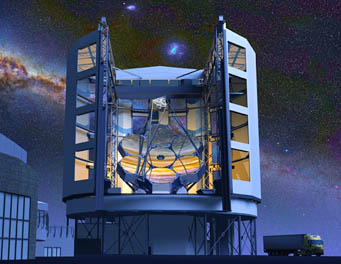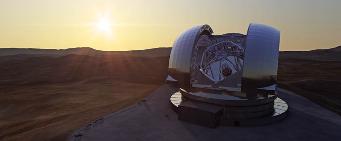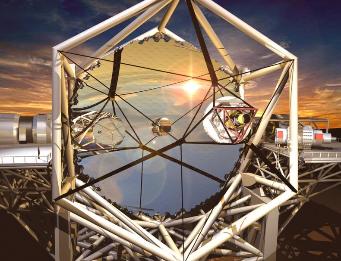
The Giant Magellan Telescope
GMTO
Robert Zimmerman writes in the March 2014 issue about the construction of the Giant Magellan Telescope, "demonstrating astronomical engineering of the highest order." The mammoth telescope will combine seven 8.4-meter (28-feet) mirrors into a flower-like primary with the resolving power of a mirro 24.5 meters (80 feet) wide.
But the Giant Magellan Telescope isn’t the only behemoth planned for the next decade. The Thirty Meter Telescope (TMT) and the 39-meter European Extremely Large Telescope (E-ELT) should also be seeing first light around the same time.
These two telescopes' primaries differ from the GMT's flower-like arrangement of circular mirror segmnts. Their primary mirrors will be tesselations of 1.4-meter hexagons: 492 for the TMT and 798 for the E-ELT. But like the GMT, the TMT and E-ELT must incorporate adaptive optics to iron out atmospheric distortion of starlight.

The European Extremely Large Telescope
ESO / L. Calçada
The science aims for this class of “extremely large telescopes” are similar, though with subtle variations depending on the instruments attached to the telescopes — each telescope has several detectors (including imagers and spectrometers) under study and/or construction. Among other things, these telescopes will detect exoplanets and investigate their atmospheres, image the first stars and galaxies of the universe, and observe the assembly of galaxies through cosmic time.
Current Status
- With more than half the funding in place, the Steward Observatory Mirror Lab has already cast three of the seven mirror segments that make up the GMT’s primary mirror, and the team has finished polishing one of them. Meanwhile, the organization has already broken ground in Las Campanas, Chile, and in mid-2014 will begin work on the GMT facility.

The Thirty Meter Telescope
The TMT Project
- The TMT has completed its design and development program and has secured about 80% of its funding. Construction will begin in April 2014, now that the facility has received approval after some contention regarding environmental and religious concerns.
- The E-ELT completed its design in 2010, passing the final design review in September of that year, but then revised the design the following year to reduce cost. In the process, the primary mirror was reduced in size from an initial planned 42 meters to the current 39.3 meters. So far, work has started on the challenging optical design of the adaptive mirror “M4,” and construction of the road leading to the summit will begin in March 2014. The organization also expects to secure all funding by the end of 2014.
For updates, see E-ELT's website.
 0
0

Comments
You must be logged in to post a comment.